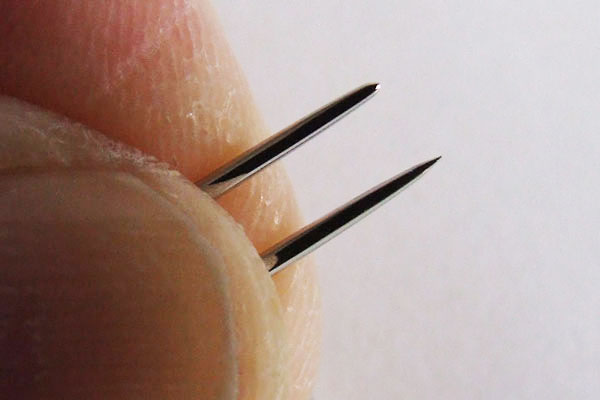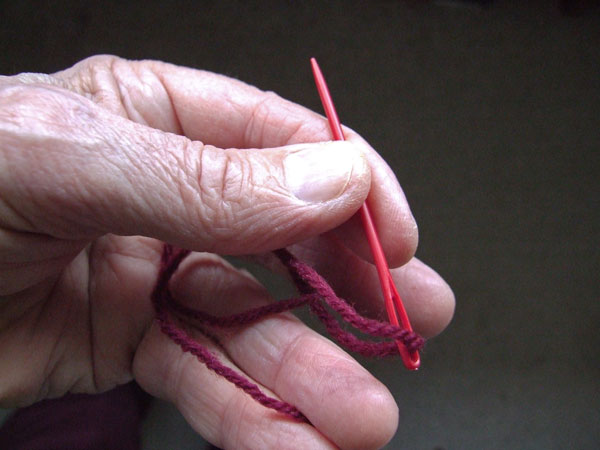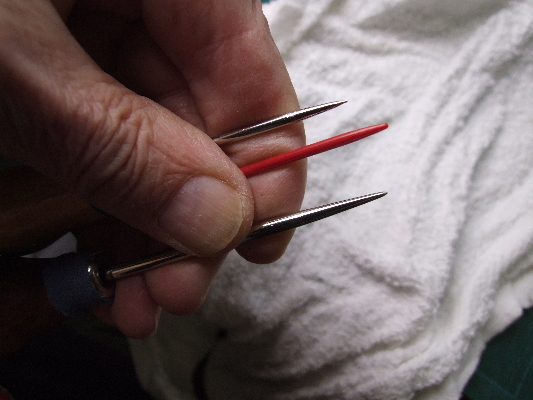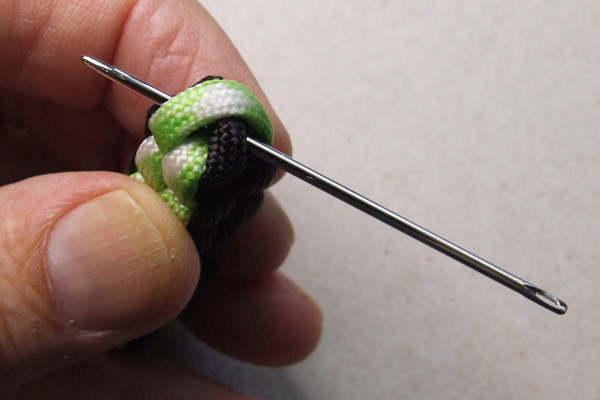
Blunt and sharp steel needle points compared
Some people may not have met the idea of blunt sewing needles, except perhaps for a bodkin [127050].
The concept of a blunt needle is commonplace amongst the knitting and crochet fraternites, although that particular adjective is rarely used ~ it suggests old and worn out. I would pefer to call them bookbinders' needles ~ but I think that there are moves afoot (2022) to call some ordinary sharps or straws by the name Bookbinder's.There was no reference to bookbinders in the catalogues of needle wholesalers a few year's back.
Here are some of my thoughts ~ intended for tyro bookbinders. (There are also some older bookbinders who might benefit from trying blunt needles ~ and introduciing them to their classrooms.) I have not used sharp needles for decades ~ since I first met a blunt needle. I find the lack of the excessive fine point to be really helpful when sewing books.


Bookbinders treat a sharp awl as an important tool ~ in use nearly all the time [125564]. They use awls mainly ~ and frequently ~ to pierce holes in papers, some of which are surprisingly tough, especially in bulk. I recently discovered a use for a blunt awl ~ something worthy of a separate note [127051].

The purpose of the point on a needle is to make it easier to pierce the fabric being sewn. The bookcrafter ~ wisely ~ makes the holes beforehand with a tool that is more comfortable to push than is a needle. Once the holes have been made there is no longer a need for sharp ~ and finger-spikey ~ points. Blunt needles are plentiful and economic ~ no excuses for not using them (other than 'Oh! I did not know!').
I have given a good reason ~ above ~ for not using sharp needles if it can be avoided ~ and here speaks someone who has pierced a thumb with the blunt end of a needle whilst pushing through something too tough. (It was soon after leaving college ~ without their equipment I was reduced to making do with the wrong tools... I leave the rest of that sentence to you...).Here is an illustration of the main reason for using blunt needles in preference to sharp ones.

There are more reasons that might encourage use of the blunt needle ~ here are several ~ in no particular order.
In craft classes ~ particularly with younger children ~ the hazards of using needles are slightly reduced if they are blunt. It is worth noting this on the H&S Risk Assessment documentation ~ as well as keeping a very watchful eye for errant waving arms.
Cordwainers (shoemakers) and shoe repairers use awls, and will have a selection of a dozen with different shapes and bends [125494]. They are necessary to arrange for holes in tough leathers, especially as they are being shaped.
The needles illustrated here are named saddlers' harness needles because horse tack is also made mainly of leather: the saddle being the most important, and most difficult, item to make. The leather has to be pierced with a very sharp ~ confortably handled ~ awl beforehand. After piercing the leather a blunt needle will follow the prepared hole better than a sharp one. A slightly misaligned sharp needle will have a tendency to make its own hole and wander into the leather.
This decorative ropework is made of polyester cord, in which the filaments are very fine. If an awl, or sharp needle, was used for this it would very likely pierce the cordage and so weaken it and maybe spoil the effect. The blunt needle was made to gently feel its way through the knot.

Tapestry needles are too short and fat for use as bookbinder's sewing needles.
=============